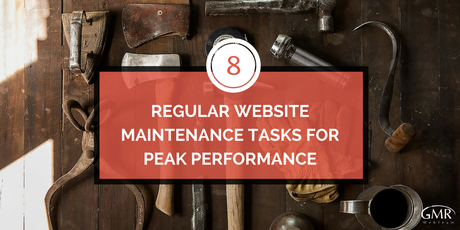
Once a website is launched it should not be forgotten by its owner. Websites don’t just evolve and attract traffic on their own, as they require regular maintenance to survive. The best way to keep a site alive is with fresh evergreen content while making sure that your site functions and navigates properly with a constantly updated website maintenance task list.
Here are some of the most important website maintenance activities to keep it in top shape.
1. Make Regular Backups of Your Site
A copy of your site needs to be stored somewhere other than the server where it is being hosted. Having a backup, especially if you make frequent updates, ensures that your site will not be destroyed in a power outage or by a hacker. Don’t rely on your host’s backups.
2. Publish Fresh Content
There are many reasons to keep creating new content for your site on an ongoing basis. Not only does it help expand listings in search engines, it gives followers reasons to keep coming back to your site. It’s also a good idea to review old content to see if it can be updated with new information.
3. Add Visuals to Make Pages More Attractive
The last thing anyone wants to see on web pages is long pages of small text with endless scrolling. If you still have these types of pages on your site, consider adding some colorful images. Text can be made to appear more readable by using a bigger font size.
4. Test Loading Speed
One of the most crucial website maintenance activities is testing web pages to make sure they load quickly. These days, web surfers only give pages a few seconds to load before they lose interest. If your site is full of slowly loading pages, it can hurt your traffic. Pages load quickest when they are not bogged down with large file sizes or complex web applications.
5. Fix Dead Links and Errors
Test your links to make sure they take the user where they are meant to go. External links are tricky because sometimes a developer will change website links without notifying anymore. It’s also important to verify that your internal links all work. Broken links can lead to 404 errors, which are annoying to users who see “page not found” messages. Screaming Frog is an SEO tool that can detect such errors.
6. Check Search Rankings
Since search engines are where most web traffic comes from, use them to find out how well your keywords rank. If you don’t see your pages coming up, even on your most niche phrases, you need to improve your SEO by rethinking your page titles and content.
7. Test Browser Compatibility
Various browsers create different versions of how your website appears to users. Test out all the different browsers (Chrome, Safari, Firefox, etc.) and make sure that your site looks presentable on all of them. Using responsive web design is generally a universal solution across all browsers and devices.
8. Analyze Your Statistics
Finally, your Google Analytics or whatever stats software you use provide the evidence to determine how well your site connects with your target market. Key stats to consider are the average number of unique visitors per day, the geography and demographics of your audience, page views, how often people stay on your site and click-throughs versus conversions.
Your website maintenance task list will be enhanced by using statistical analysis to inspire new content that may improve the quantity and quality of your traffic. Consider holes in the market that aren’t being served by your competitors by brainstorming with your team to uncover new niches.
![8 Regular Website Maintenance Tasks for Peak Performance 8 Regular Website Maintenance Tasks for Peak Performance [Pin]](https://m5.paperblog.com/i/168/1686231/8-regular-website-maintenance-tasks-for-peak--L-Owkywn.png)

